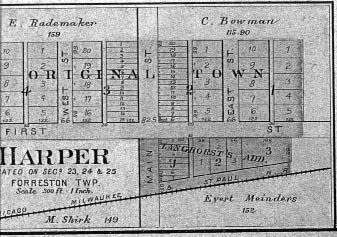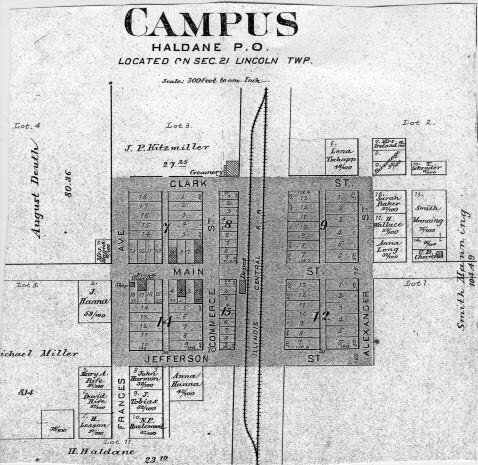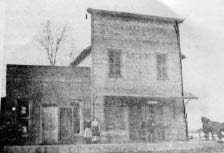
Discover rewarding casino experiences. 
Click on the Flag for More Information |
Haldane, for instance, has several physical reminders of another day ... Streets and commerce lining them, not abandoned. Many homes remain to tell us of its one-time bustle. Its station on the Illinois Central Railroad was as an agricultural stop—to haul away grain crops and livestock to market. Its inception was in 1856 and that by Alexander Haldane who was a grain dealer, building a grain elevator and a residence that year. He served just about every office in town and section as there was; town clerk, justice of the peace, postmaster but his principle job was as the agent for the Illinois Central. The Illinois Central had begun as a grandiose idea in 1837 to run from Cairo at the southern tip of the state, to the northern regions which eventually would be Freeport to branch east-west in both directions. A Great Depression, however, overtook the country and squelched most development for some time. Sporadic attempts to revive it took place but it wasn’t until in 1853 that it again became viable with those tracks creeping up the length of the state as far as Ogle County. There were to be five stations in that county; Woosung, Polo, Haldane, Forreston and Baileyville. Grain elevators dominate the skyline still, now serviced by motorized vehicle! With the coming of the railroad, a rapid rise in population/settlement took place, each expecting to become a metropolis. Why some grew and others didn’t is a puzzle that only a social scientist could answer, perhaps. In Haldane’s case it wasn’t for lack of hustle on the part of Alex Haldane and the others with whom he, apparently, was in collaboration. He was described as a “man of individuality,” certainly meaning those characteristics of a positive personality. And for the fact that he held many positions of trust. He was agent for the IC Railroad for twenty-five years although at different times he submitted his resignation. Each time the railroad company refused it because he was such an excellent employee.
He was a stalwart Democrat, that party urging him to run for the state legislation in 1870. He was defeated by the Republican nominee. Haldane was noted as a “man of cultivation,” born in Scotland in 1805 where in 1830 he married Frances Palmer of Southhampton, England. Four years later they emigrated to America, to the East, apparently, but in 1856 they came to Ogle County where he immediately began to put his stamp on the neighborhood, “investing in a tract of land.” One reference stated that “with others he laid out a town.” Another that it was “Haldane and Hitt of Mt. Morris” that the town was platted (last week, Maryland Station, etc., 1873). Jointly, it’s said, they were to develop track side property that eventually became Haldane but not before other machinations. Reference gives that the two men had a dispute as to what name the track side lots should have but what two men is not clear to yours truly in the manner it is written. As Haldane built the first house and a grain storage as a grain dealer it seemed apparent that it would become “Haldane.” But no. As you see a plat here of “Campus,” allegedly named for someone by that handle with Haldane post office being a governmental title. The Campus plat spans both sides of the railroad tracks although the 1976 county history states that was on the east side of the tracks with the Haldane portion being on the west. Also, the United Brethren Church was on the east side, 1862, while an Evangelical Church constructed on the west, that in 1884. Because of nearly a twenty year difference in origination, the churches seem to have avoided any feud. The first store, general merchandise, was begun by two men from Mt. Morris and because the stop was a “water” station, it grew in size because, after all, that took several employees to take care of that necessary chore. There were three water tanks to soften the water used for the steam engines so the boilers wouldn’t lime up. There were three wells and a pump station, a busy place. Around the railroad there came a butcher shop, blacksmiths, a barber shop with a pool hall and grain elevators dominating the skyline. The picture of the store building is taken from the 1976 Ogle County history. It still stands though unused since the last quarter of the twentieth century. A party of the neighborhood’s “leading citizens” surprised Alex and Frances Haldane in June, 1880 to celebrate their fiftieth wedding anniversary. “Large and elegant gifts graced the room,” repayment for the geniality and generosity” of the happy couple. Haldane, far from is native land had adapted well to the “New World” and had certainly repaid it for his investment in America. He died at an advanced age in 1888, his widow two years later. They are buried in Fair Haven Cemetery, Polo where they attended the Presbyterian Church for many years. No other monument exists to the Scots who, like their fellow countrymen, did much to built the U.S. of A. with such discipline and creativity. Wouldn’t you have liked to know them?
Signs pointing to Haldane can be found leading off both Rt. 26 south of Forreston and from Rt. 64 also. Another H is for Harper— Although a sign east of Shannon on Rt. 72, three miles west of Rt. 26 and one mile south, is the site of Harper, there is almost nothing there to indicate the depot town in the midst of corn and bean fields. It was once a station/agricultural stop on the Chicago, Milwaukee, St. Paul Railroad. Oh, if you are one of those “sensitives” to the aura cast by the one-time energy of the past you could feel a lingering presence but it would take some concentration. The eight to nine neat homes and bins there do indicate a “gathering,” perhaps, but one time there was the “depot” of Harper. In the past there were six rail lines through Ogle County and their successors, predecessors, combining and revisions that are all quite a conundrum. The C, M. St. P. was a later arrival. It had reached Byron from Chicago via Elgin in 1875 but it didn’t continue westward until 1880 striking Ogle, or rather creating other “stations at Monroe Center, Davis Junction, Stillman Valley, Leaf River, Adeline, Forreston then Harper. The “company paying liberally for the right-of-way and giving the territory the best of rail facilities,” source prompts. Harper’s east most neighbor, Forreston, was a railroad town, believe or not. It was the junction of the IC and the Chicago and Iowa line (1872), later a branch of the Chicago, Burlington and Quincy. To accommodate all the traffic and because it was the end of the line of the Burlington, there was a sixteen stall roundhouse to turn engines for returning back up the track. It was bustling with railroads and railroadese. George Hewitt platted an addition to Forreston named “North Forreston” in 1881. It had a population of ten but served originally as “home” for some of the workers at the “Junction.” The concentration of rail yards at “North Forreston,” as it was separately called, saw construction of grain elevators, storage, homes and commerce to mark its progress. Harper on the fertile prairies that grew the crops for the markets, had to be satisfied with less commerce because Forreston had become the center instead. But at Harper there was a grocery, blacksmith, a lumber yard, elevator and grinding plus the “depot,” a picture of it would be a treasure if there was one. All are nonexistent today. There is no hint of the one-time railroad either, the once thriving CMStP that roared through with the excitement pervasive that in the late nineteenth and half the twentieth century. It donated society for seventy-five/hundred years in the automotive age when trucks succeeded the train which couldn’t go just everywhere!! Only a scattered, remote history may recall those little hamlets and villages that dotted the countryside and were the firm building blocks of our nation. Once you might say they had been in the “middle of nowhere” but were “the center of everything” in their day. They have an individual story to be told. Harper was one of them. NEXT WEEK—Two more H’s.
|






